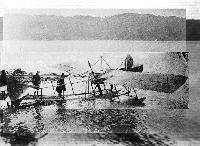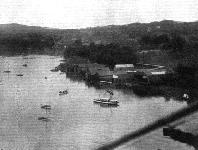P.Lewis British Aircraft 1809-1914 (Putnam)
Lakes Hydro-monoplane
The Lakes Hydro-monoplane was another of the aircraft flown so successfully from Lake Windermere by the Lakes Flying Company. A two-seat pusher, it was designed for Captain E. W. Wakefield by Oscar T. Gnosspelius and was built during 1913 by Borwick and Sons, of Bowness-on-Windermere. An 80 h.p. Gnome was used and the machine, flown initially by Rowland Ding, continued in useful employment by the Northern Aircraft Company - as the Lakes Flying Company became later - until 1916 for the training of R.N.A.S. pilots. When it first appeared the aircraft was equipped with a wide central float and two smaller wing-tip floats. These were afterwards exchanged for a pair of main floats only.
Показать полностью
M.Goodall, A.Tagg British Aircraft before the Great War (Schiffer)
Deleted by request of (c)Schiffer Publishing
LAKES monoplane (Later NAC monoplane)
This pusher type monoplane seaplane was designed by O.T. Gnosspelius, and was made for the Lakes company by Borwick and Sons of Bowness in 1913-1914. The first flight was made in September 1914 by W.R. Ding, who had taken over the company by this time, and renamed it the Northern Aircraft Co. The aircraft was damaged on several occasions, including having the whole tail section broken off in May 1915 and, although repaired, was finally written off at the end of that month.
The pilot and passenger sat in tandem in a nacelle of rectangular section with a curved prow. The engine was attached at the rear, with the propeller in front of the engine, and the wings joined at the top longerons. The tail surfaces were attached to a braced, outrigger structure of tapering depth, which was carried forward to provide a chassis for mounting the single main float. This was attached to the nacelle by three pairs of struts and to the wing center section by two more pairs. Triangulated pylons, above the center section, provided anchorages for the wing bracing wires. Lateral control was by ailerons. Inflatable floats were fitted under the wings and tail.
As with previous Lakes seaplanes, the original single step central float was replaced with single step twin floats, covered with aluminum alloy sheet, in which form it flew first on 1 May 1915. The wing and tail floats were deleted and the tail surfaces increased in area at the same time.
Power: 80hp Gnome seven-cylinder air-cooled rotary fitted with an Integral propeller
Показать полностью
J.Bruce British Aeroplanes 1914-1918 (Putnam)
Lakes Flying Co. (later N.A.C.) Monoplane
BY the end of 1912 the Lakes Flying Co. found that the Water Hen was no longer able to cope on its own with the growing demands for pleasure flights. The company therefore commissioned O. T. Gnosspelius to design a new floatplane for use on Lake Windermere.
Mr Gnosspelius had designed a little monoplane with a broad-beamed central float in 1911. With it he had attempted a flight shortly before the Water Hen first flew, but the Gnosspelius machine was overturned by a gust of wind just as it took off. It was later successfully flown on February 13th, 1912.
Mr Gnosspelius had an original turn of mind, and the new floatplane that he designed for the Lakes Flying Co. was almost unique, for it was a pusher monoplane. The machine was built by Borwick & Sons of Bowness.
The monoplane wing was mounted at the level of the upper longerons of the boat-shaped nacelle. An 80 h.p. Gnome engine was fitted at the stern of the nacelle. There were four tail-booms: the upper pair were attached to the wing, the lower pair to the undercarriage bracing system. The wings were braced by cables; landing loads were taken by cables running from a double cabane system.
The original undercarriage consisted of a large central float, with outboard floats for stability. A small tail float was also fitted.
The monoplane was taken over by the Northern Aircraft Co. in 1914; thereafter it was usually referred to as the N.A.C. hydro-monoplane. Like the Water Hen, it was later given a twin-float undercarriage with two single-step pontoon-type floats. When these were fitted the outboard floats were removed.
After the outbreak of war, the monoplane shared with the Water Hen the duty of training seaplane pilots for the R.N.A.S., and was used in that capacity until 1916.
SPECIFICATION
Manufacturers: Built by Berwick & Sons, Bowness-on-Windermere, for the Lakes Flying Co.
Power: 80 h.p. Gnome.
Показать полностью
Журнал Flight
Flight, November 13, 1914.
WATERPLANE FLYING AT WINDERMERE.
ALTHOUGH comparatively little has been heard with regard to the activities of the school and works of the Lakes Flying Co., on Lake Windermere, a good deal of constructional and school work has been done, resulting in the production of several school machines and a number of pilots, some of whom have turned out really fine flyers. Under the management and direction of Mr. E. W. Wakefield, who has up to quite recently been the director and owner of the Lakes Flying Co., a machine of original design has been evolved and given excellent results, which does its designer, Mr. Gnospelius, as well as its constructors, the Lakes Flying Co., credit.
Arrangements have now been considered for the Northern Aircraft Company, Ltd., whose director and manager, Mr. W. Rowland Ding, is well known as a particularly successful pilot of the Handley Page biplane, to take over the whole business of the Lakes Flying Co., including the hangars, machines, plant, &c, and it is intended to start immediately with the school and works. The present equipment of the school comprises three machines, including the new monoplane referred to above, whilst the construction of new machines will be commenced at once. As Mr. W. Rowland Ding, in addition to being an experienced pilot, is also a capable designer, the appearance of the new machines will be awaited with interest.
It seems likely that the new school will quickly become popular, for Lake Windermere is in a very attractive flying venue, owing to its elongated shape, a "straight" of eight miles in length and an average width of about three-quarters of a mile, increasing in places to slightly over a mile.
As most of the tuition work will take place over the lake, the danger of serious accident should be remote, especially as a motor boat of 12 h.p. is always in attendance upon the waterplanes. Apart from the waterplanes it is intended to build several land-going machines, so that pupils will have an opportunity of making themselves acquainted with the handling of both types. Attached to the school is also a very fine hydroplane, fitted with a 50 h.p. water-cooled Clerget engine. This boat has a speed of about 50 m.p.h., and will carry four passengers. It will be at the disposal of the pupils, and should form one more attraction to the, in this respect, already well-provided school.
Mr. Ding's own description of his first experience with the water monoplane, of which we hope to be able to give full details later, forms very interesting reading, and, incidentally shows how easily a capable pilot, who has had no previous experience with waterplanes, can master the handling of this type of aircraft. Mr. Ding puts his initial efforts on the Lakes machine as follows :-
"On arriving at Windermere I found that there were three machines: 1. The 'Water-Hen,' the Farman-type biplane with front elevator, built by the Lakes Flying Co., of which a description, with scale drawings, appeared in FLIGHT some time ago. 2. A 50 h.p. Gnome-Avro biplane. 3. A very interesting 80 h.p. 'pusher' monoplane, designed by Mr. Gnospelius and built by the Lakes Flying Co., this machine being not quite finished.
"I decided at once that the third machine was the one which would probably put up the best performances, and I therefore packed the others in different hangars out of the way and set to to finish it off. As soon as finished I had this machine placed on its bogey and run down into the lake, and after a short preliminary run of the engine, which behaved splendidly, I set off on my first waterplane trip.
"I may say that I have never seen a waterplane in the air, and only know what it looks like from photographs. It was with some fear and trepidation that I opened the engine out and waited to see what would happen. One or two seconds after I started I found that I had not the throttle adjusted quite right, and therefore began to adjust it in order to get more speed out of the engine. So busy was I doing this that I did not notice that I had left the water and got some 20 feet into the air, and when I found what had happened I felt very relieved indeed, as I had been told that about the first thing I would do would be to get the front of the float under the water and turn a somersault!
"The machine felt so nice in the air that I took it straight up to about 600 or 700 ft., and managed to do quite small circuits. I found out, however, that the side areas were all wrong, and the machine had a great tendency to spin, this being probably due to the fact that it has a very large square-sided body, protruding out in front of the machine a la Henri Farman, with not much fixed tail area at the back to counteract it. After the first flight I therefore had a large fin made and fitted to the rear of the machine, and, on trying it again, I found that this was a wonderful improvement, as the machine now seems as nice to handle in the air, although somewhat slow, as any I have tried, and there is no tendency to spin at all. The third flight I made with a passenger of about 12 1/2 stone, and this flight was quite successful. The machine lifts a passenger quite well and will do as small circuits as any machine I have seen.
"I find landing on the water quite as easy as landing on terra firma, except perhaps when the Lake is so smooth that it looks like glass, but one soon gets used to this too.
"I am sending you several photographs of this new machine, which deserves to be noticed, as it is of a type which is distinctly original, and which, if it was a little faster (its present speed being about 55 m.p.h,), would be as good a flying machine as any in the country, especially considering that at present it has on it a somewhat heavy and old 'single' float which was not designed for it."
Показать полностью








